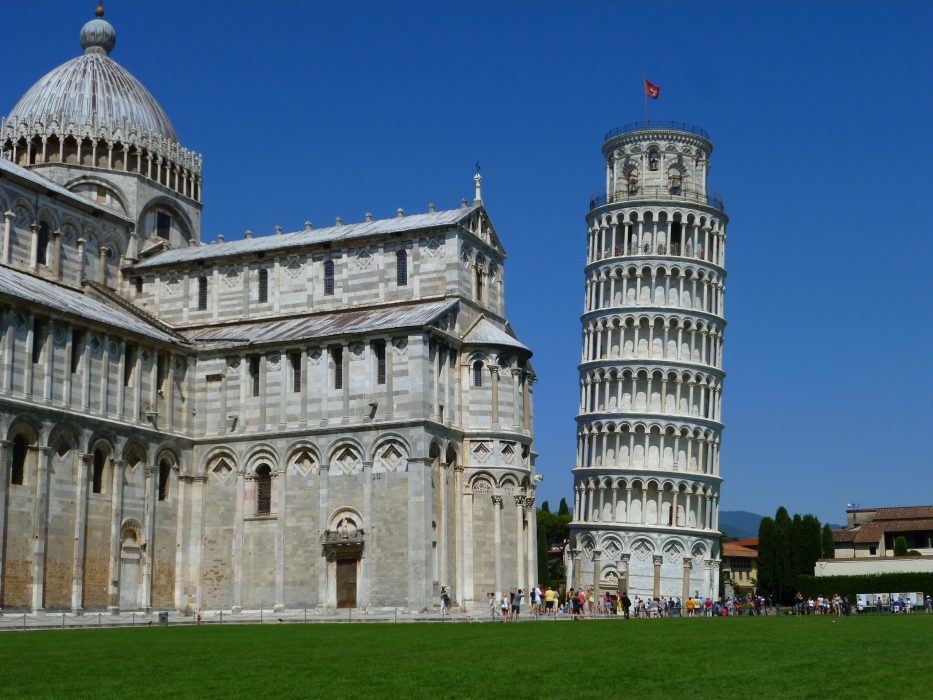
The truth about Pisa and its Leaning Tower
The superstar among the leaning towers of the world is clearly the Leaning Tower of Pisa.
Located in the town of the same name in Italy, it attracts millions of tourists every year, making it one of Italy’s main attractions. Besides Venice, of course, which is also the focus of tourists.
But did you know that the Leaning Tower of Pisa is just ONE building in a complex of many monumental buildings?
The Tower: an Italian superstar
I keep reading about the Leaning Tower of Pisa and how enthusiastic people are about it. Instagram and Facebook are paved with pictures of people, who seem to lick, lean against or climb up the tower. All of this, of course, from the photographically correct angle. It’s funny, though.
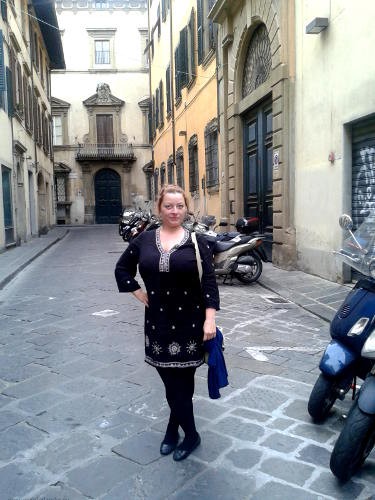
When I was on my way there myself, I did not expect much, to be honest. I was not keen on masses of tourists who swarm around an (ok, impressive) leaning tower, lonely on wide corridors. It was something like that, but not really, because the situation is much more diverse than expected! That is why it is important to me to write this article and to draw attention to all the other wonderful buildings that surround the tower.
To find Piazza dei Miracoli, the place where the tower stands, you only need to follow the signs, coaches or tourists. All roads lead to Rome… uh…to the tower.
Who built the Leaning Tower of Pisa?
The entire complex around the tower in Pisa belongs to the archdiocese of Pisa, to the Roman Catholic Church. It built the cathedral, beginning in 1063, in an innovative, cross-shaped floor plan, with a total construction period of 200 years. Later also the tower of Pisa, which is actually only an accessory to this imposing cathedral.
An impressive round tower made of marble was planned, also a novelty for that time and later a model for other towers in Siena and Florence. The architects, among them the sculptor Bonanno Pisano, planned the bell tower of Pisa with a total height of 100 metres and construction began on 9 August 1173. It should also serve as a refuge for church representatives in an emergency.
But what happened?
Why is the Tower of Pisa leaning at all?
In those days, construction work on large buildings took much longer than today. By contrast, the embarrassing delays around the construction of Berlin’s new Schoenefeld Airport are a no-brainer. After a hefty 12 years of construction, the third floor was completed and it was noticeable for the first time that the tower was gradually leaning south-east.
Today the reason for the incline of the Leaning Tower of Pisa is known: In ancient times, the area in which the entire complex is located was still an island directly situated by the Mediterranean Sea.
Pisa was a sea power at that time and later in the Middle Ages in constant power struggle with the Venetians.
More and more building land was created by progressive siltation. The square Piazza dei Miracoli is located on this square, and the tower even stands directly on the shore of the former sea.
Pretty cool, actually, huh?
For this reason, however, the foundation under the weight of the 14,000-ton tower is also gradually weakening. The soil conditions of clay and sand were not considered by the architects of that time. This is a construction error according to today’s standards. I guess back then also.
When will the Leaning Tower of Pisa fall
Have you ever asked yourselves: When does the Leaning Tower of Pisa actually fall? Personally, I also wonder quietly: What does Pisa do when that happens? There is not much else there and virtually the entire economy, even in the immediate surroundings, is designed for mass tourism.
Well, besides the university, whose students make up about 40,000 and half the population of Pisa. Will we then see the tower with a huge crutch in the shape of a scaffold to prevent it from falling? That would be fun to watch.
No, the tower won´t fall.
The tower had its greatest inclination so far at 5 degrees in 1993, which is problematic for a building. A worldwide call was made, asking statisticians to work out a solution to stabilize the famous Tower of Pisa.
Initially, lead weights of 850 tons stabilized the foundation on the opposite side of the incliniation, then a system was developed with which loamy soil is repeatedly exposed in continuous “maintenance”, thus minimizing the inclination. The tower will probably remain care-intensive forever. We see: it will probably not happen that the militant little tower of Pisa simply falls over.
Scientist discover the tower’s secret
Beware, a bit nerdy!
A team of scientists now discovered the secret behind the tower’s strong-hold. The tower’s survival seems to be a result of a process they call “Dynamic soil-structure interaction (DSSI)”.
In accordance with this theory, the height and rigidity of the Tower itself, coupled with softness of the soil in which it has its foundations, has meant it does not vibrate in the same way as everything around it does as a result of earthquakes. So basically the same thing that makes the tower lean (soft soil), lets it survive seismic events and prevents it from falling.
The cathedral and its bell tower
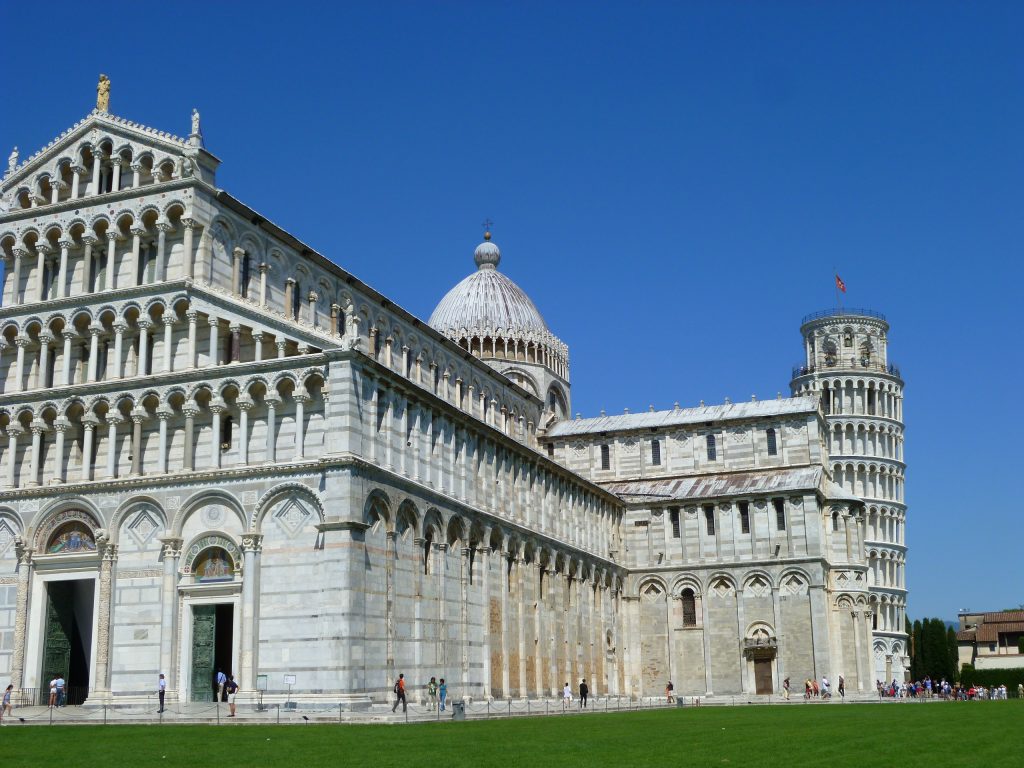
First of all, the old town of Pisa is a really tiny, nice place. A few streets, many restaurants and horse-drawn carriages. Outside, the village has grown and expanded to include single-family houses with land and highways. A day trip here is enough. In a few hours, you’ve seen everything.
Embedded in the city – Piazza dei Miracoli
(“Square of Miracles”)
From the rather narrow entry road you unexpectedly come to the large square, which ends on a large meadow and is surrounded by the old city wall.
Here you find your tickets and some tours:
Three masterpieces of medieval architecture stand up here in dazzling white:
- the impressive cathedral of Santa Maria Assunta in Piazza del Duom (to which the bell tower belongs)
- a cemetery complex “Camposanto Monumentale“
- the Baptistry
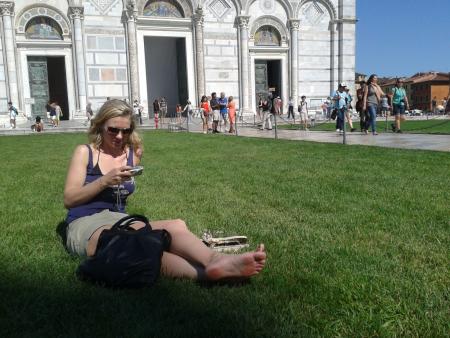
In the midst of these beautiful, monumental buildings, the famous Leaning Tower almost disappears into a sea of deep green, radiant sky blue and white marble stones. The tower was once planned as a free-standing bell tower for the cathedral in Pisa. But that didn’t happen. In general, the well-kept meadows are a good opportunity to relax or
sunbathe.
When the 7 bells of the tower ring daily at 12 noon, the crowds are at their highest, also at the small souvenir flea market at the edge of the area, in the shadow of the city wall. This wall encloses almost the entire area and is interrupted by small passages.
The Cathedral of Santa Maria Assunta
You have to see the impressive Cathedral next to the tower! From the outside incredibly fine marble ornaments and inside impressively large with a wonderfully painted dome. The cathedral was built in the Middle Ages and although it was actually built in honour of Santa Maria Assunta, its original name was Santa Maria Maggiore. Its current appearance is due to repeated restorations and changes, also on the outer façade.
This construction work took place in various eras, the most significant change being probably after a devastating fire in 1595, during which the entire roof had to be rebuilt.
Cemetery complex “Camposanto Monumentale”
The accompanying cemetery Camposanto is small, but surrounded by spacious walkways and a wall. In the corridors with semicircular windows and old stone floors it is cool and shady. One hardly dares to speak in this silence, in which every word echoes.
If you are looking for silence and an escape from the masses of tourists, this is the place for you. Since 1987, the entire complex of tower, cathedral, baptistery and cemetery has been a UNESCO World Heritage Site.
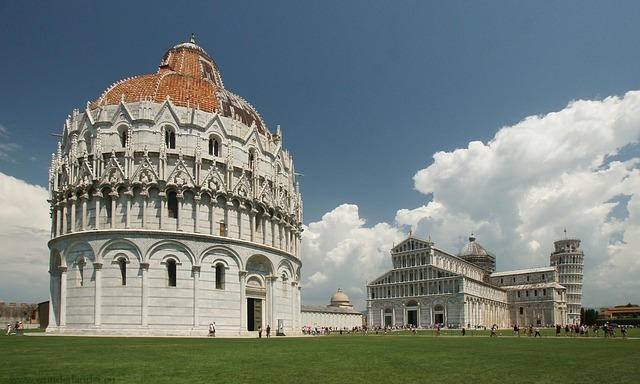
Baptistry
Opposite the cathedral stands the Baptistery, begun in 1152 and finished with Gothic elements in the 14th century. It was built on the model of the Anastasis rotunda of the Holy Sepulchre in Jerusalem. It houses a baptismal font and is the largest baptistry in Christian history.
Because of the cylindrical construction, a very special acoustics can be found inside the rotunda. If you are lucky, one of the guardians will tune a song or individual tones, which will become a real sound experience due to the special echo behaviour of the architecture.
How to buy tickets for the leaning tower of Pisa
You can find ticket on many different pages of different companies. Depending on where you come from, a ticket to the monuments can already be included in the price you pay for the whole trip to the leaning tower of Pisa.
Tickets can be bought up to 20 days upfront the visit, as there is only a certain amount of visitors allowed at the tower at the same time. There are no reduced tickets for the tower.
Some companies sell at a higher price and make a revenue out of it. I cannot list them all here, so I give you an idea about the real round about pricing. You can then decide yourself, if an offer from a third party travel company is expensive.
Normally a ticket to the leaning tower costs 18,00 €. There are no reduced tickets for the tower.
The other tickets depend on the number of monuments you want to visit (normal rates):
1 monument around 5,00€
2 monuments around 7,00€
3 monuments around 8,00€
More information
Who takes care of the leaning tower of Pisa?
Guardians of the monuments: Nowadays as a non-profit organization, the “Opera della Primaziale Pisana” (OPE) was established around the time of the first works for the erection of the monuments in Piazza del Duomo back in 1064. This date is proven by two famous inscriptions on the façade of the Cathedral, the time the first stones were laid. The purpose was:
Protection, defence, preservation and maintenance, as well as promotion of the image and enhancement, without interfering in church services, of the Cathedral, the Baptistery, the Bell Tower, the Monumental Cemetery, the Bishop’s Palace, the Church of San Ranierino, the Museums and all their appurtenances
Source: https://www.opapisa.it/en/opera-della-primaziale-pisana/statute/
Since 1987 the group of monuments of Piazza del Duomo di Pisa has been declared World Heritage by UNESCO. Since 1999 the Opera has had the legal status of a non-profit organisation, subject to its own Charter, which includes, among its institutional purposes, the “protection, promotion and enhancement of its artistic heritage”.
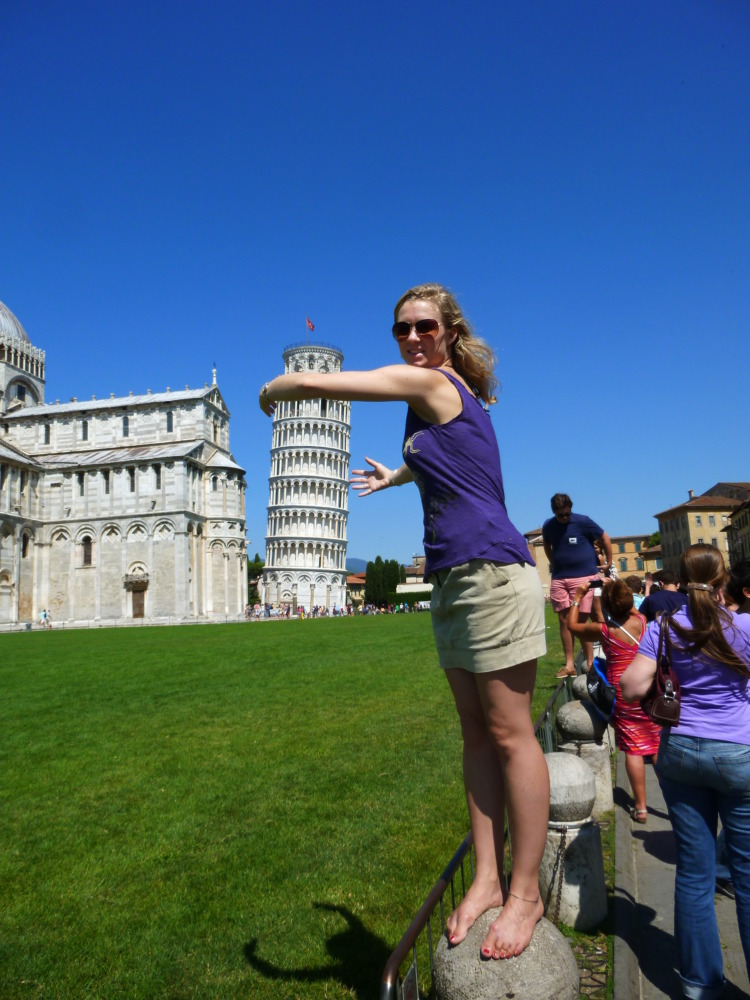
How to make the famous Pisa Tower pictures
Those who have always wondered how the famous licking and hugging pictures are taken with the tower, which circulate the internet a thousand times over: The meadows are lined with stone pedestals, on which you stand and then pose in the right angle with the tower. In the evening, when the coaches have left, the tourist flea market closed and the day tourists tired, you can really enjoy the whole charm of this complex.
Get a bottle of wine from one of the surrounding bars or supermarkets, sit on the benches or stone pedestals in twilight and enjoy the view. Or treat yourself with some of the famous food from Italy in one of the many restaurants around.
Unfortunately, the complex is not illuminated at night but the snow-white marble still gives an idea of the constructions. Wonderful !
By the way: Famous sons of the city are Galileo Galilei and Fibonacci.
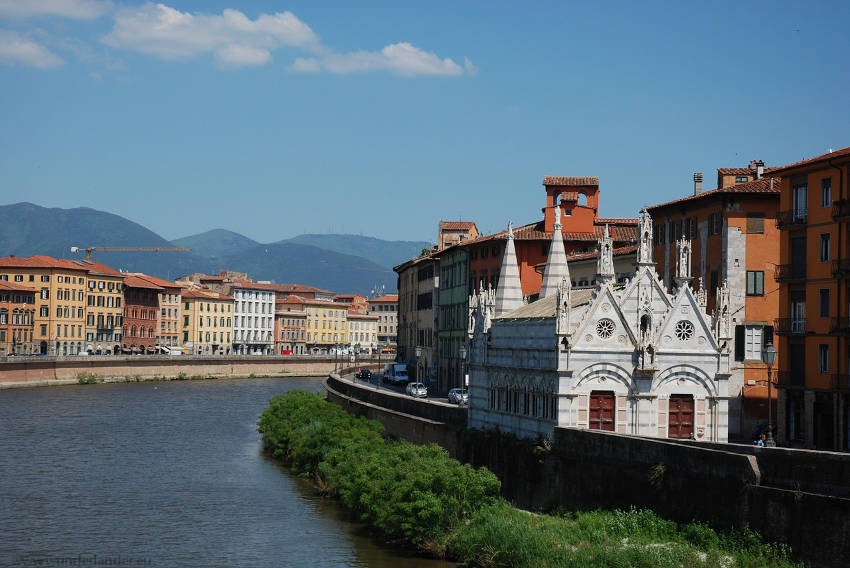
The outskirts of Pisa
If you have explored Pisa enough, the surroundings offer many interesting destinations. A trip along the Italian Riviera offers enchanted villages, mountainous natural parks and many historic buildings. The Cinque Terre National Park is only the most famous of the many attractions on the coast of northern Italy.
Enjoy your trip to Pisa in Italy.
With love from Berlin




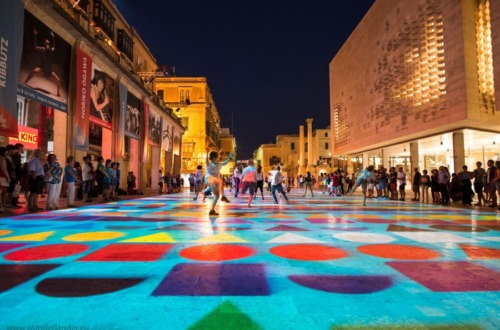
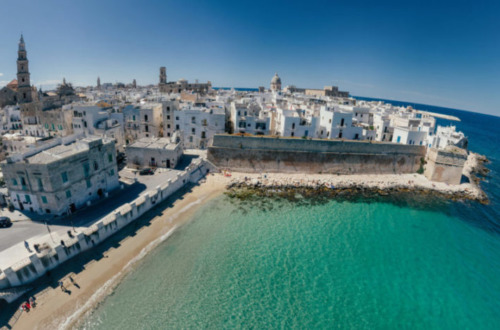

11 Comments
sara
My husband and I went to Pisa in 2016 and thought it was amazing! The Baptistry was actually my favorite part. Your article did a great job of explaining all the history of the buildings!
Erika Ann
The facts that you put in here are really interesting to read. I would love to visit Italy and take a picture at the tower of pisa. Its one of the places I have in my bucket list. Its awesome to read about the history of it and why it is actually leaning.
Tadej
It would be nice to visit it for hiking. Hey I like you hugging the tower, it is original 🙂
Suzy
haha, thanks.
Karen
I absolutely agree with you love! The leaning tower is cool and all but I always wondered if there was anything else aside from it. So glad I read your post 🙂
David
Have always been fascinated by the leaning tower, but thanks for pointing out other areas of interest around.
mydayinlosangeles
I would of been just as interested in the medieval buildings as you! Refreshing to here that there is more to do than just take pictures of a leaning tower
Culture Trekking
I have heard that the town itself is not that exciting. Would you agree? I thought it was interesting and exciting that you included something else by the leaning tower of pisa, but I’m not much for tourist traps anyway. So it was nice to have something refreshing about this site that makes me actually want to explore and go now.
Guide to Get Lost
Amen to giving the tower a rest and exploring what’s around it! So much hidden beauty in Pisa outside of the tower. Great post!
thatssodarling
Hmm.. I have never been! So interesting getting your take on it!
Harbors and Havens (@harborsnhavens)
We didn’t even bother stopping here when we went to Italy. It seems like it’s basically a photo op. Nice to hear about the other buildings.